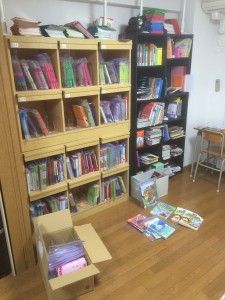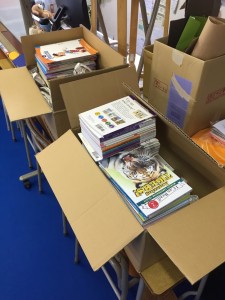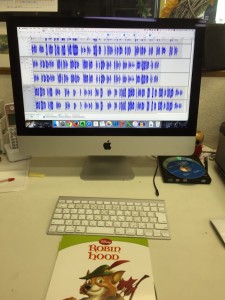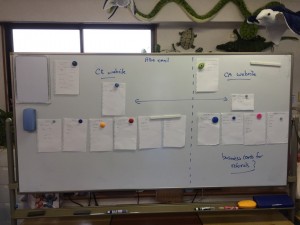business curriculum extensive listening extensive reading high school junior high school school management self-study
by sendaiben
11 comments
Cambridge Academy (six months in)
Extensive Reading for Secondary Students Part 2
Well, we’ve been running the Cambridge Academy for about six months now.
Academy classroom
Cambridge Academy (see previous write-up here): so far so good. We’ve run into some problems and changed course a couple of times, but the program is shaping up and it’s time for a big recruitment push. In this post I will talk about some hiccups we encountered, solutions, and future plans.
Problems so far
1. We still don’t have enough books
2. Some books don’t have commercially available audio
3. We don’t have a coherent program beyond the beginner level (over YL0.9)
4. Some students (10%>) are not performing well
5. Writing activities are not a good fit for an extensive reading class
Solutions
1. We continue to buy books and process existing ones (label and put into database and reading checklists) so that students can use them. We’ve probably doubled our existing readers since April and will probably continue doing this for the foreseeable future. Practice is making better, and our processing is getting much quicker now.
Processing new books
Processing new books involves the following steps:
- open box, remove plastic wrapping etc.
- find YL/word count information
- label books with SEG labels
- input book information into our reader database
- copy CDs and put away the masters
- put books and CDs into ziplock bag sets
- add book/set information to reading checklists
- put books on the shelves
The two major problems are if books don’t have YL/word count information, and if books don’t have CDs/audio. Right now we guesstimate YL and count words if the books are short enough. For longer books we try to find the word counts online. This site is great to find US-published series.
2. For books with no commercial audio available, we have been making our own by reading the books out loud into an iMac using Audacity to produce mp3 files that we then burn to CDs using iTunes. So far this is working very well, but it takes quite a long time and we still have over 500 books to make CDs for!
Recording audio
3. None of our students have gone beyond YL1.0 yet, but a couple of them will reach it soon. Before that happens we need to make sure we have enough books for them to read. Another problem is what to do about audio. I suspect that by the time students go over YL1.0 audio will be less important, but I am not 100% sure.
The other question is whether to continue grouping books into sets or to move to having individual books. If individual books, what will the checklists look like? I suspect all of this will get worked out over the next six months or so.
4. We have two problems with some of our students. The first is that a small number of students (two or three) seem to be exaggerating the amount they read or reading in a very perfunctory way (just looking at the pictures). I’m not sure how much of a problem this is, as they may well still be getting some benefit from the audio input. If it is a problem, I don’t really know what to do about it. I have tried talking to them, asking them about the content of books, and had them read the books out loud to me, but I am still not happy about the situation. Work in progress.
The other problem is potentially more serious. So far only one student seems to have run into it. Basically the student seems to have hit a wall around YL0.3, and is reporting that they cannot understand anything in the books at that level. I have tried talking to the student and explaining that it’s not necessary to understand everything but rather important to try and catch familiar words and think about the meaning, but I am not sure how helpful that was or how to solve this if it comes up with other students. Another work in progress.
5. Our initial model bundled extensive reading and writing practice (through weekly writing assignments) into one class, with speaking activities in the other. However, this model has several important drawbacks and we’ll be changing it in the future. Our ER classes have up to 12 students in them, so checking each student’s writing in 55 minutes is really hard and quite stressful for the teacher. Checking writing assignments in the ER class also means that our teaching assistants cannot take the class (they would be able to if it was just ER). Finally, having writing assignments in the ER class makes the class more stressful and less fun. Students are worried about finishing their writing instead of just relaxing and enjoying the reading class.
From next year we will include the writing assignments in the communication class (output), while the ER class will focus on reading and listening to the accompanying CDs.
Future plans
We have a few plans not mentioned above. The first and most important is that now that the program is getting into a half-decent shape, it’s time to try to expand it and recruit more students. So far all our students joined from within the school. Only half a dozen or so joined the school once the Academy was running, and we haven’t been actively advertising the course.
Business cards for advertising
From this week we will start actively trying to recruit new students, through our new Academy webpage and various advertising campaigns. Our goal is to have 100 students in the Academy by December 15th this year.
Planning the new website
Our website is getting a bit dated so we plan to get a new one made in November this year.
We are also going to explore whether the ER class is a standalone product. At first we went off the SEG model, which pairs an ER class with a communication class, but my friend DE suggested that the ER class might be our main product, with the communication class as an optional extra. This would be much easier to provide logistically, so I am excited to see if it is true over the next couple of months.
Another thing that we need to work on is making the ER classroom more comfortable. Right now it is set up with school-style desks and chairs, but we are planning to make more of a cafe-style with more comfortable chairs and funkier design/lighting/etc. Ideally it should be a welcoming space that students want to spend time in, and prospective students are attracted to. Work in progress, but I hope to post some pictures in the next update.
We need to find another couple of teaching assistants so we can train them before expanding the number of classes. We’re looking for 2nd-year university students at the moment.
Eventually we are hoping to open new branches in other parts of the city. I think that will be an option once we have 200 students at the original location. Another work in progress!
Any questions or advice? Please comment below.




